

 marcopolo@chinatoursnet.com
marcopolo@chinatoursnet.com
Home / Beijing Travel Guide / Beijing Dining

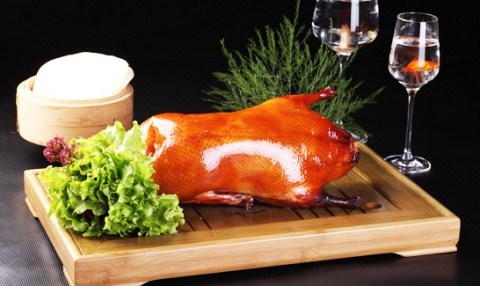
Peking Roast Duck
Peking duck, also known as Peking Roasted Duck or Beijing Kaoya, is a dish of great antiquity from Beijing that can trace back to the imperial era. Nowadays, Peking Duck had become one of the specialties of the capital and a national symbol of China, favored by tourists and diplomats alike. For instance, Henry Kissinger, the former Secretary of State of the United States, came to savor this cate, during his two visits to China in 1971 and in 1976. It has also been a favorite delicacy for various political leaders ranging from Cuban Fidel Castro to former German chancellor Helmut Kohl. The delicacy is characterized by its crisp skin shining date-red in color and tender texture, with authentic versions serving mostly the skin and little meat, sliced in front of the diners by the cook. The hot Peking Roast Duck will be brought to the dining table by the chef where he will slice it into more than 100 thin flakes, each having its piece of crispy skin. The meat is often eaten with spring onion, cucumber and sweet bean sauce with pancake rolled around the fillings. Sometimes pickled radish is also inside, and other sauces can be used. The remaining duck with meat and bones can be cooked in three ways. The traditional way is to be cooked into a broth. The meat together with bones can also be stir-fried with sweet bean sauce, or rapidly sautéed and served with salt and Sichuan pepper. Besides the traditional one, many restaurants offer an All Duck Banquet - various dishes cooked with the offal and juices of the duck, surrounding the main dish. It will be sure to give you satisfaction and enjoyment when dining. Duck has been roasted in China since the Southern and Northern Dynasties(386-589). Up until the Southern Song Dynasty (1127-1279), ducks were roasted in the area around Jinling (ancient name for Nanjing). A variation of roast duck was prepared for the Emperor of China in the Yuan dynasty(1271-1368). The Peking Roast Duck that came to be associated with the term was fully developed during the later Ming dynasty when the rulers moved their capital city to Beijing from Jinling and by then, Peking Duck was one of the main dishes on imperial court menus and was highly regarded by emperors and other members of the ruling classes. By the Qianlong Period (1736–1796) of the Qing dynasty, the popularity of Peking Duck spread to the upper classes. The first restaurant specializing in Peking Duck, Bianyifang, was established in the Xianyukou, close to Qianmen of Beijing in 1416. Preparation Raising the duckNewborn ducks are raised specially in a free range environment for the first 45 days of their lives, and force fed 4 times a day for the next 15–20 days, resulting in ducks that weigh 5–7 kg. The force-feeding of the ducks led to an alternate name for the animal, Peking Stuffed Duck. Seasoning the duckA suitable fattened White Beijing Ducks are slaughtered, plucked, eviscerated and rinsed thoroughly with water. Air is pumped under the skin through the neck cavity to separate the skin from the fat. The duck is then plunged in boiling water for 1 to 5 minutes, then hung to dry. This will tighten the skin and help the duck to achieve its traditional crispy texture. The duck is then glazed with a layer of potentially spiced and flavored maltose syrup. A marinade of traditional flavorings, including soy sauce and five-spice powder, and more maltose, is then applied inside the body cavity. This will flavor the duck during the next step. The duck is then left to dry for between 24 hours and several days in a cool, dry place, which allows the skin to crisp while roasting. Roasting the duckHitherto, there are two traditional schools of cuisine for the duck cooking, namely closed oven and hung oven. Closed-oven stylePeking duck is originally roasted in a conventional closed oven, allowing the meat to be slowly cooked through the convection of heat within the oven. Controlling the fuel and the temperature is the main skill. In closed-oven style, duck meat is combined well with the fat under the skin, and therefore is juicy and tender. Hung-oven styleThe hung oven, also known as open oven, was developed in the imperial kitchens during the Qing Dynasty. It is designed to roast up to 20 ducks at the same time with an open fire fueled by fruit hardwood from peach or pear trees. The ducks are hung on hooks above the fire and roasted at a temperature of 270 °C (525 °F) for 30–40 minutes. While the ducks are roasting, the chef may use a pole to dangle each duck closer to the fire for 30-second intervals. By the means of hung oven, the fat is usually melted during the cooking process, so the skin is more crispy. The initial technique has been perpetuated by very few restaurants among which the household name Bianyi Fang is the representative. The second method is relatively well-known and used with great success by the notable Quan Ju De Restaurant, first established in 1864, which won the China Renowned Trademark as well.

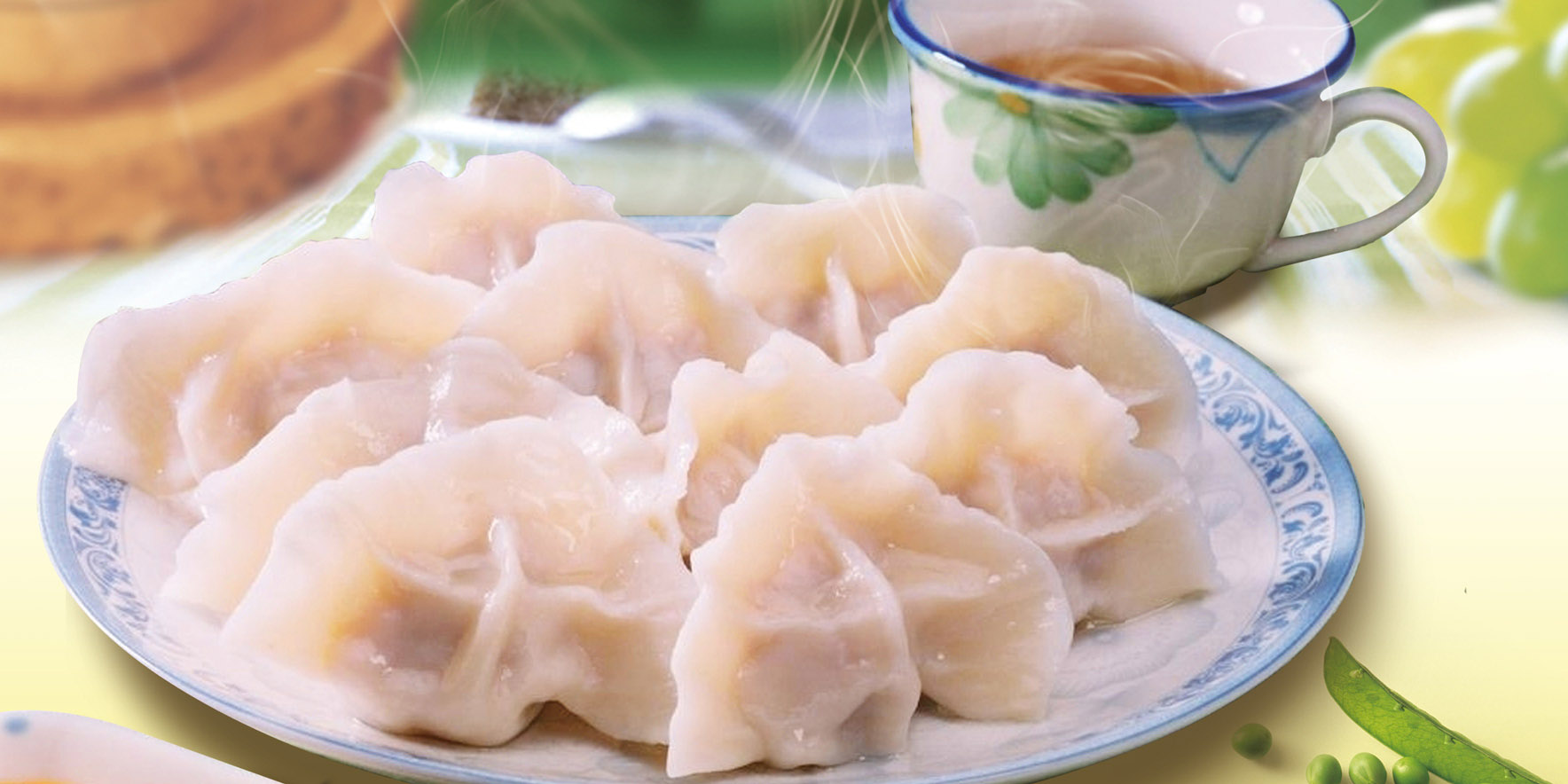
Dumpling
Introduction of Chinese Dumpling: Dumplings with meat and vegetable fillings, is very popularthe Chinese new year and at other festivals. It tops the list of delicacies of people in north china, where people eat dumpling at midnight on new year‘s eve and for breakfast on new year’s day. The history of dumpling dates back to ancient time. But the custom of making dumpling a special dish during, started in the Ming dynasty, some 500 years ago. The reason is simple. The appearance of dumpling looks like the V shape gold or silver ingot used as money in ancient china. As the spring festival marks the start of a new year, people choose to eat dumpling to connote their wishes for good fortune in the new year. Althoughhas changed, the tradition has remained. But today, dumpling is considered more as a sign of propitious blessing than of fortune. as china is a country with a vast territory, there are great differences in various regions in ways of making dumpling or even serving it. There is no set rule as to what makes dumpling filling, they can be anything from vegetables, meat to seafood. Whatever the fillings, the wrapping skill needs to be exquisite to make dumpling look attractive. Ways of serving dumpling also vary from place to place. Generally, dumpling are boiled in water and served with vinegar, soy sauce, garlic or chilli oil if one likes them hot. Many families in china usually prepare enough dumpling to last several days of the spring festival time. To make dumpling, first of all, chop the meat into tiny pieces and mash tem, then add salt, sesame oil, soy sauce, ginger, scallions, Chinese cabbage and MSG if you like. Mix thoroughly the ingredients and meat filling, add 2 spoonful of water if necessary. In a big bowl, add water to flour gradually. Mix and knead by hand to form soft dough, then cover it with towel and put it aside for about an hour. Then scatter some dry flour on the board, knead and roll it into small pieces. Press each piece with you hand and get a pancake. Finally, to hold the pancake with your palm and put the filling in the center and wrap in to half moon shaped and seal the edges. Next step is easy. Put the dumpling into boiling water, when it is well cooked, it is ready to be served. However before eating you need to prepare some small dishes to contain the mixture of soy sauce vinegar and sesame oil or chilli oil. There have been so many varieties of dumpling that it is no longer a rare scene for restaurants to offer a whole dumpling banquet, serving up several dozen kinds of dumplings. If you are interested and want to experience the fun of making dumplings, you can book a tour containing the making dumplings.

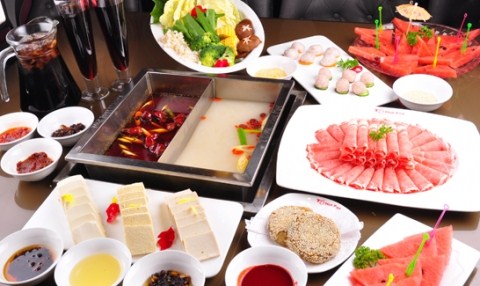
Hot Pot
Hot pot, and the less common Chinese fondue, refer to several East Asian varieties of stew, is ke consisting of a simmering metal pot of stock at the center of the dining table. While the hot pot .is kept simmering, ingredients are placed into the pot and are cooked at the table. Typical hot pot dishes include thinly sliced meat, leafy vegetables, mushrooms, wontons, egg dumplings, and seafood. The cooked food is usually eaten with a dipping sauce. In many areas, hot pot meals are often eaten inn the winter. The Chinese hot pot boasts a history of more than 1,000 years.While often called "Mongolian hot pot", it is unclear if the dish actuall originated in Mongolia. Mongol warriors had been known to cook with their helmets, which they used to boil food, but due to the complexity and specialization of the utensils and the method of eating, hot pot cooking is much better suited to a sedentary culture. A nomadic household will avoid such highly specialized tools to save volume and weight during migration. Both the preparation method and the required equipment are unknown in the cuisine of Mongolia of today. Hot pot cooking seems to have spread to northern China during the Tang Dynasty (AD 618-906). In time, regional variations developed with different ingredients such as seafood. By Qing Dynasty, hot pot had become popular throughout most of China. Today in many modern homes, particularly in big cities, the traditional coal-heated hot pot has been replaced by electric,gas or electromagnetic cooker versions. Because hot pot styles change so much from region to region, many different ingredients are used.


Kung pao chicken
Kung Pao Chicken (宫保鸡丁) Learn Chinese- Chinese Cuisine Kung Pao ChickenOne of the most famous Chinese foodKung Pao Chicken (or Gong Bao ji ding) is a typical traditional Sichuan dish made with diced chicken, peanuts and chili pepper. Kung Pao chicken is a very popular staple of North American Sichuan-style Chinese restaurants, and many recommend using it as a measure of the skills of a chef. History Kung Pao ChickenIt was named after a court official Ding Baozhen in the late Qing dynasty (1616-1911). Legend has it that Mr. Ding was a gourmet, relishing stir-fried diced chicken in particular. While he served as governor in Shandong and Sichuan, he often treated his guests to this dish. While in Sichuan, where the local people liked hot chilies, Ding Kung Pao Chickenimproved his favorite dish stir-fried diced chicken by adding chili pepper to the ingredients. As a result, the dish with its spicy flavour tastes more delicious. Since Ding was later granted the title Taizi Shaobao, which literally means protector of the crown prince, by the imperial court, he was also referred to as Kung Pao, which was short for Taizi Shaobao. In memory of Mr. Ding Baozhen, people named his favorite dish Kung Pao Chicken. The dish exists in both traditional Sichuan and Westernized versions; the latter is more popular in the United States and Canada. Kung Pao Chicken Recipe INGREDIENTS 2 large boneless, skinless chicken breasts 2 1/2 tablespoons of sesame oil1 teaspoon of Szechwan peppercorns (optional) 8 red, dried chili peppers3 cloves of garlic1 tablespoon of freshly grated ginger6 green onions, chopped 2/3 cup of roasted, unsalted peanuts . For the marinade 2 teaspoons of soy sauce 1 1/2 teaspoons of sherry or Shaoxing rice wine1 tablespoon of water 2 teaspoons of cornstarch. For the sauce 3 teaspoons of Chinkiang or 2 teaspoons of apple cider vinegar2 teaspoons of soy sauce? ?1 teaspoon of sesame oil1 tablespoon of water3 teaspoons of sugar1 teaspoon of cornstarch METHOD 1 Mix together the marinade ingredients. Chop the chicken into bite sized pieces and toss them in the marinade and set aside. 2 Combine all the ingredients for the sauce, whisking well to ensure the cornstarch is fully incorporated. Set aside. 3 Thinly slice the garlic. Break the chilies open and discard the seeds inside, then cut them into a few large pieces (the dish will already be very hot, keeping the seeds will make it near inedible). 4 Place the 2 1/2 tablespoons of sesame oil in a wok or large saute pan and place over medium-high heat. Add the chilies and Szechwan peppercorns if using. Stir-fry for a few second until they become fragrant being careful not to burn them. Add the chicken, as soon as the pieces have separated add the ginger, garlic, and green onions. Stir-fry for a few minutes until the chicken is cooked through. 5 Add the sauce and toss. When the sauce becomes thick add the peanuts, toss, and serve. Serves 4.

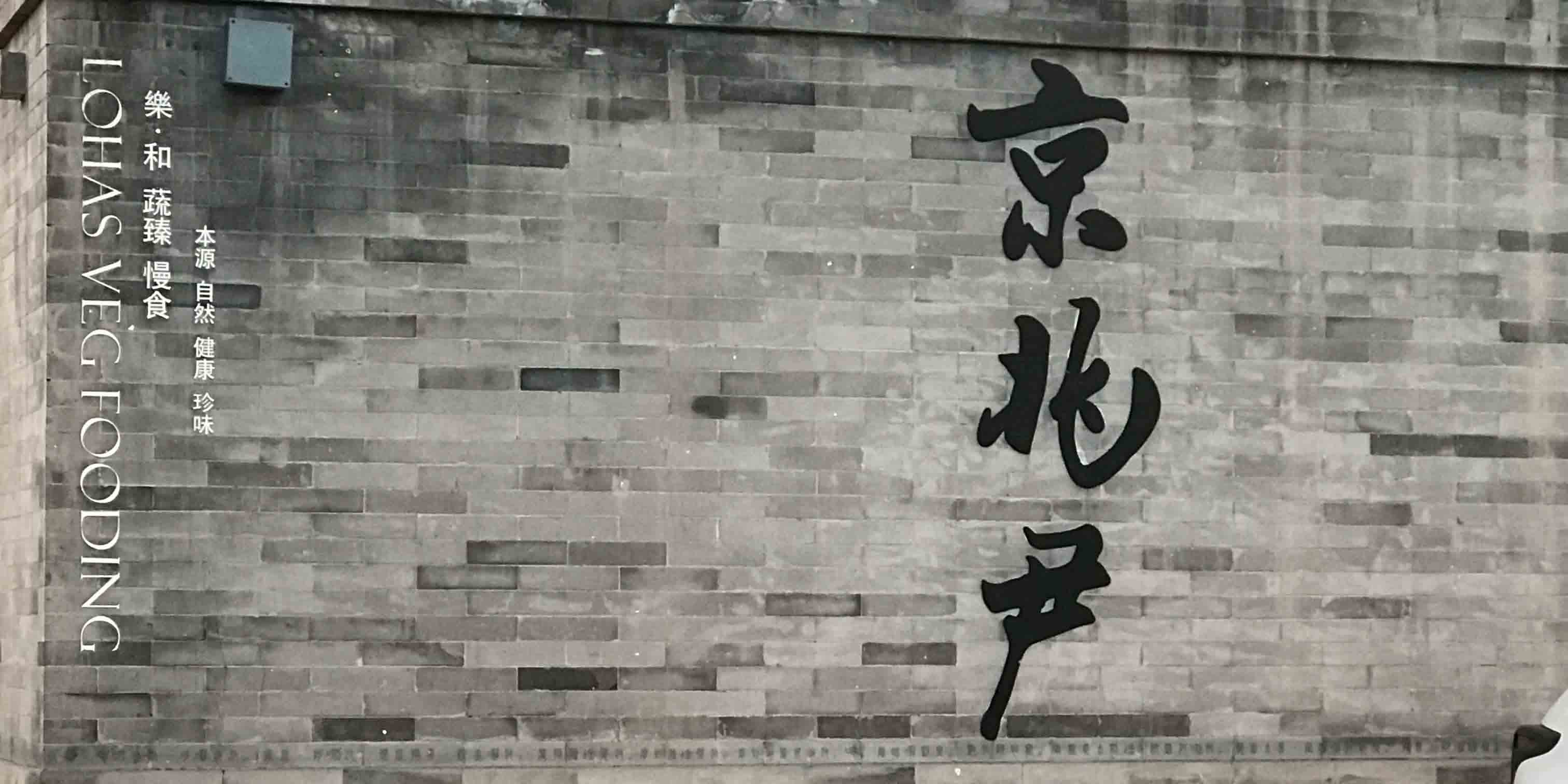
King's Joy
The name King's Joy (pronounced as Jing Zhao Yin in Mandarin Chinese) is the title of the ancient Chinese government official, the equivalent of today’s capital city Mayor. It is set in a quadrangle courtyard (known as siheyuan in Mandarin Chinese, which is a historical type of residence) with a 5-star ambience, only a stone's throw from the famous Lama Temple, stepping onto the grounds of King's Joy is like taking a step into the past. Restauranteur’s homage to a sustainable, healthy lifestyle has attracted a large following among celebrities, dignitaries and the well-heeled, elite from Beijing. King's Joy presents a sublime and upscale dining experience that is somehow simultaneously spiritual, luxurious and vegetarian. Along with the attentive but not overly intrusive waiting staffs that speak good English, providing friendly and professional service, each morsel is a piece of culinary art work, exquisitely prepared and presented. Guests would be surprised by the diversity of pioneering delicious taste, the beauty of plates, and the elegant surrounding. In the heart of the restaurant, underneath the sun-kissed roof, sits a lady playing the harp. Guests are treated to a live harp performance most afternoons. A tranquil harmony governs this sleek mashup between a traditional Chinese setting and modern western style. In addition to the interior restaurant seating, customers can also choose to dine amongst a grove of small bamboo trees at the rear of the space. Even when the restaurant was packed, you do not need to shout to hear your friend talking. In this spacious restaurant, the tables were spread far enough for privacy and comfort.You could either take your time flipping through the seemingly never-ending list of delicacies in the massive menu, or you could opt for their well-thought-out set course menus which features creative meatless offerings, lots of organic and upmarket vegetarian food like Sweet and Sour Monkey's Head Mushrooms, Stuffed Lotus Pancakes, Red Curry with Scallion Pancakes, Eggplants, Yam with Special Sauce, Scrambled Tofu and Egg with Pancakes, Stir-fried Pea Sprouts, and etc.. King's Joy also features an area that celebrates the traditional Chinese tea ritual --- a refined way to begin or end your meal. The beautifully aged tea is considered to be the perfect companion to the meal.Restauranteur’s homage to a sustainable, healthy lifestyle has attracted a large following among celebrities, dignitaries and the well-heeled, elite from Beijing. King's Joy is committed to bringing together the best in both Eastern and Western Vegetarian culinary arts to Beijing. Putting on the table the best, freshest vegetable ingredients from around the world combined with the craft of a Michelin three-star, renowned Master Vegetarian Chef, who direct supervision, using only raw materials that meet or exceed the stringent selection criteria. King's Joy pledges to use only 100% fresh, naturally grown ingredients meeting the KJ-001 exporting standard in the cooking. It is pricy but worthwhile for a special occasion, romantic, relaxed. When you find it's time to cleanse both your mind and body, there's nothing wrong with doing it in style. Tips for dining: Address2 Wudaoying Hutong, Dongcheng DistrictHours of operationLunchDaily 11:00 am–1:30 pmAfternoon TeaDaily 2:00 pm–4:30 pmDinnerDaily 5:30 pm–8:00 pmCuisinesVegetarian / VeganDining StyleFine DiningDress codeBusiness CasualAdditionalBeer, BYO Wine, Gluten-free Menu, High Tea, Non-Smoking, WinePraise:Gafencu presented the Best of the Best 2015 Awards at the Grand Kempinski Hotel Shanghai Pudong. King's Joy was mentioned amongst leading world-class luxury brands such as Aston Martin, Bentley, Maserati, Rolls-Royce Motor Cars, Bally, Bottega Veneta, Burberry, Ermenegildo Zegna, Givenchy, Hermes, Stefano Ricci, Tiffany & Co., Audemars Piguet, Cartier, Patek Philippe, Ulysses Nardin, Rolex, Vacheron Constantin, Atlantis Yachts, Azimut Yachts, Boeing, Louis XIII, Dom Perignon, Moet & Chandon, Royal Salute.
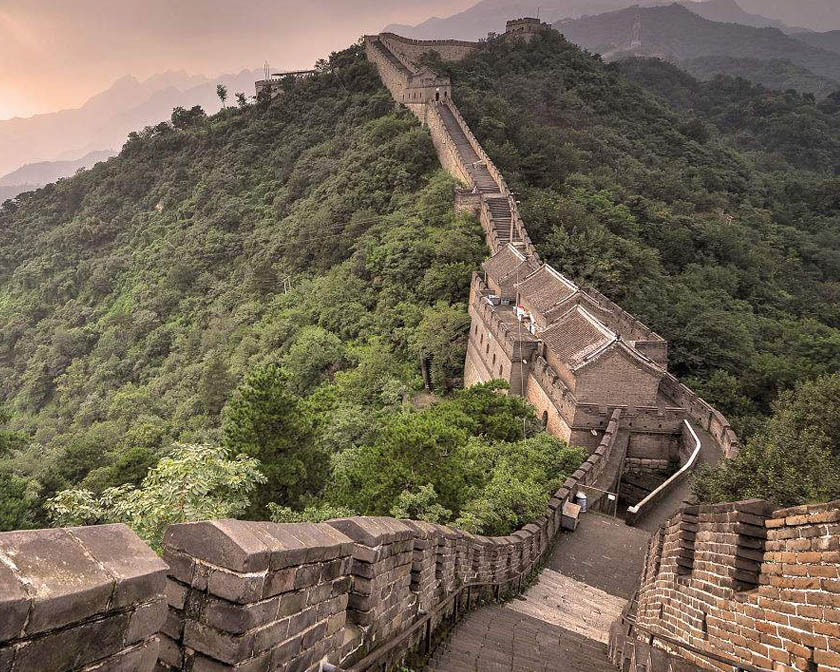
Welcome to Beijing! Visit two of the most famous UNESCO World Heritage Sites in 1 Day Beijing Group Tour, explore the Great Wall of China at Mutianyu which is the longest defensive project in the world and Ming tombs which was a tranquil peace land in the suburb of Beijing.
1 Day Beijing Tour: Mutianyu Great Wall and Ming Tombs (Changling)

Beijing includes both “sightseeing and food and wine”. Chateau Changyu Afip Global Winery has a reputation of making one of the best-quality wine in China meanwhile a place for you to learn the culture and history of wine (importing wine since Tang Dynasty). Since the 90s cooperation with French winemakers improved Chinese wine quality dramatically. Next, visit Gubeikou Water Town, next to Simatai Great wall section, enjoy "some Venice of the east town" close to Beijing.
Beijing 1 day Chateau Changyu Winery and Gubeikou Water Town Tour

Discover China's ancient and modern history on this 1 day private tour and learn about our human ancestors at the Peking Man Site with a friendly private driver and guide, explore the UNESCO world heritage for scientific study on human evolution and go back in time at the Marco Polo Bridge on a flexible itinerary, meaning you can choose other attractions of your interest along the way if there is free time.
1 Day Beijing Tour to Peking Man and Marco Polo Bridge

Your tour is incomplete until you have experienced Beijing’s colorful nightlife. Their evenings are full of art shows and unique performances. Ditch the pub, watch a Chinese acrobatics or a Kung Fu show. If you want to enjoy the traditional Beijing, book your place at the Peking Opera. Our Beijing night tour has a lot to offer you! Meanwhile, you can enjoy the traditional food of China (dumpling).
Beijing Night Show With Dinner Tour